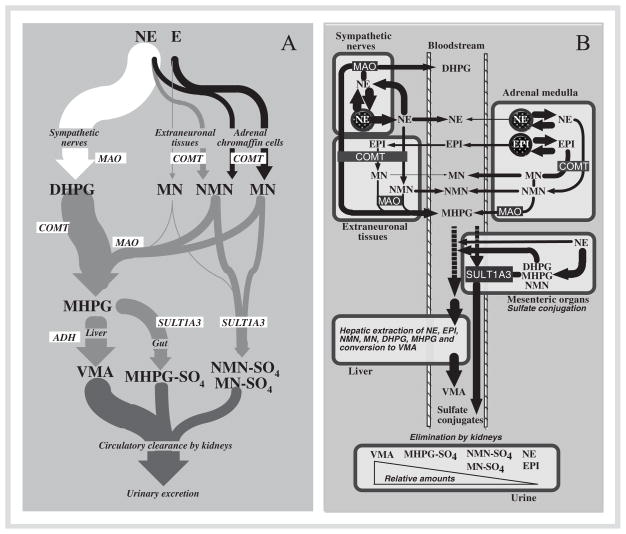Fig. 1.
Diagrams showing the three main pathways for metabolism of catecholamines derived from sympathoneuronal or adrenalmedullary sources (panel A) and further illustrating the regional nature of catecholamine metabolism in different compartments (panel B). The sympathoneuronal pathway (shown in white in panel A) is the major pathway of norepinephrine metabolism and involves intraneuronal deamination of norepinephrine leaking from storage granules or of norepinephrine recaptured after release by sympathetic nerves (see panel B). The extraneuronal pathway (shown in grey in panel A) is a relatively minor pathway of metabolism of catecholamines released from sympathetic nerves or from the adrenal medulla, but is important for further processing of metabolites produced by neuronal and adrenalmedullary pathways. The adrenalmedullary pathway (shown in black in panel A) involves O-methylation of catecholamines leaking from storage granules into the cytoplasm of adrenalmedullary cells (panel B). Sulfate conjugation of catecholamines and catecholamine metabolites occurs mainly in mesenteric organs, whereas production of vanillylmandelic acid (VMA) occurs mainly in the liver. These represent the main metabolites excreted in urine. Abbreviations: NE: norepinephrine; E: epinephrine; DHPG: 3,4-dihydroxyphenylglycol; MN: metanephrine; NMN: normetanephrine; MHPG: 3-methoxy-4-hydroxyphenylglycol; VMA: vanillylmandelic acid; NMN-SO4: normetanephrine sulfate; MN-SO4: metanephrine sulfate; MHPG-SO4: 3-methoxy-4-hydroxyphenylglycol sulfate; MAO: monoamine oxidase; COMT: catechol-O-methyltransferase; ADH: alcohol dehydrogenase; SULT1A3: sulfotransferase type 1A3.

